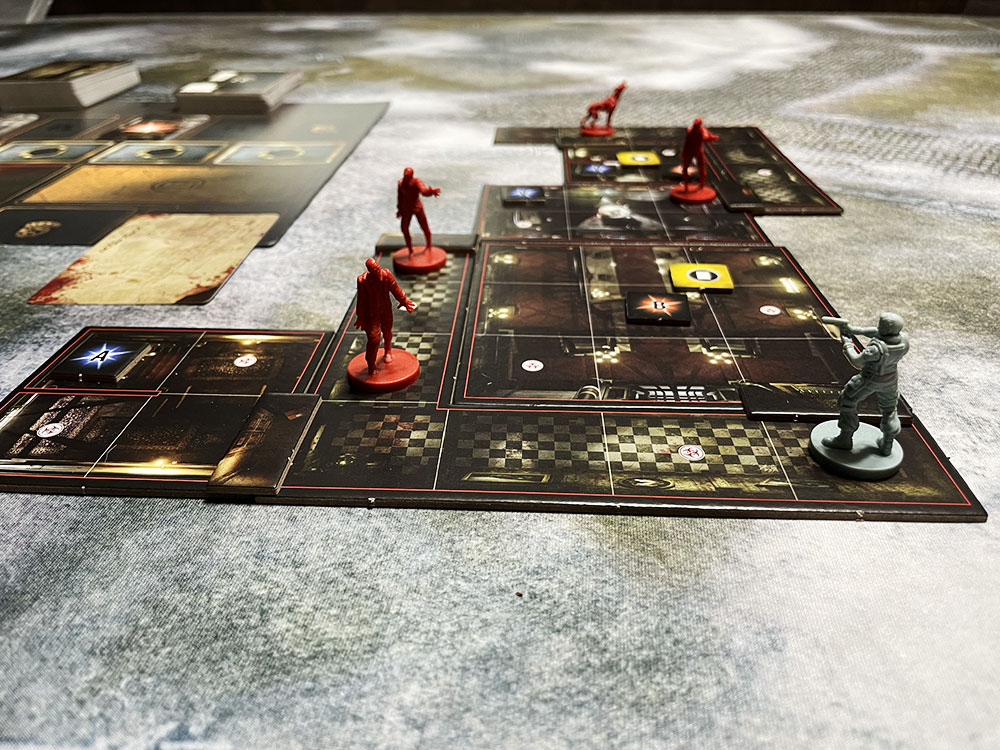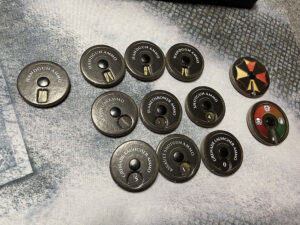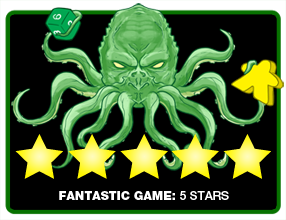After bizarre murders take place in the Arklay mountains outside of Racoon City the Special Tactics and Rescue Squad, or S.T.A.R.S., team is sent to investigate. Ambushed by monsters, they have taken shelter in a mansion deep in the woods. Have they fled to safety or deeper into danger?
Resident Evil is a co-op dungeon crawler with a campaign mode designed for 1-4 players and takes between 60-90 minutes per scenario.
Gameplay Overview:
Resident Evil has two distinct modes you can play, one shot or the campaign that closely aligns with the video game it is based on. Set up will generally be very similar, with some extra steps for the campaign mode. Each player will select their character and receive their starting equipment. Based on the scenario chosen, the tile board can be set up. In some scenarios, the board will continue to grow while exploring.
Each player’s turn in the game is split up into three main phases.

The first phase is where players will take their actions such as move, attack, open and close doors, and search for items. Here players need to be careful, as enemies will move towards the sounds of combat, forcing players to choose when to fight or flee. Players will search different rooms for clues and trigger exploration cards while exploring the halls of the mansion. Depending on each character’s starting equipment each player is also provided an ammunition counter to keep track of their dwindling ammo supply.
The second phase is the reaction phase. This is where the enemies on the board that are alerted to player characters will move and attack.
The last phase is the tension phase. This is where the active player draws the top card of the tension deck and follows its directions. This can range from nothing happening at all to enemies breaking down doors and zombie corpses reanimated.
The scenario lasts until the players either succeed or become overwhelmed by the horrific creatures stalking the halls.

Game Experience:
Playing through Resident Evil the Board Game felt like slipping into a warm comfy sweater of nostalgia. I was able to play through the tutorial mission and the first campaign mission and loved every second of it.
The tutorial is played using all the basic rules of the game. It was a great way to ease into the combat system and the turn sequencing. The turn structure is intuitive and once you become familiar with the game, the pacing feels really fast. Moving around the mansion was pretty seamless, the only time I lost track of things was trying to see if a door was open or closed at a glance. It was a little tough to see some of the darker details on the board, but I think that has more to do with the setting and art of the game and not a production issue.

The scenarios I played contained zombies and cerberus (zombie dogs), and the combat system still felt nerve-wracking. Not only is ammo limited but enemies aren’t always completely dead, meaning you can’t accurately count out the bullets you will need to make it through the map. Watching your ammo counter slowly dwindle at the table and arguing over who should take the next shot at an enemy increases the dread every time a monster rears its head. The difficulty to hit and do damage to your target is determined on the weapons card, with some weapons having special rules.
The pistol had a wonderful push-your-luck mechanic allowing for re-rolls with the same attack action but costing more ammo. Attacking enemies caused other enemies to lurch into actions that were on the same tiles or where I had left a door open. I actually had a zombie in my second mission slowing making his way through all the doors I had carelessly left open, which was an awesome flavor win.

The tension system uses a card deck consisting of green, amber, and red cards with increasing dangers that are occurring around you in the mansion each turn. The encounter cards also add additional effects, making every move you take a calculated risk.
The game has an intensive campaign mode that seems to have been painstakingly designed to capture all the highlights from the video game. Having characters to switch out to and being able to store items as you watch the mansion slowly become more dangerous around you feels exactly like the remake of the game. The base game I reviewed also came with two bosses, Lisa Trevor and the Tyrant. They have a deck based activation system allowing them to move around the board and attack with different actions while you fight to survive.
Final Thoughts:

Resident Evil the Board game ticked all the boxes for me on what I want to see and what friends expect when I take this game off the shelf. The combat system is smooth with great resource-managing mechanics and evasive options. The monsters behave exactly how they would in the video game, and the campaign looks and feels like I sat down with a Capri Sun, some sour patch kids and booted up my Game Cube to play some Resident Evil for the afternoon.
Each mission has enough differences to keep you guessing and the mansion mapping system is a great addition to keep your exploration fresh. I would have loved to have some 3D doors to help keep track of what is open and closed since it is such an important mechanic, but that is a small complaint in a sea of positives. If you are a fan of the Resident Evil video game, you can’t pass up this great board game adaptation.
Final Score: 5 Stars – A great dungeon crawler with a robust campaign mode that perfectly captures the feel of the video game it is based on.
 Hits:
Hits:
• Combat is fast and tension filled.
• Campaign mode is robust, and pretty accurate to the video game.
• Exploration keeps you on edge with tension deck and encounter cards.
• Board game captures the spirit and feel of the video game.
Misses:
• Art in some places feels a bit darker and hard to see on the board (especially doors).
• May need expansions for a “completionist” experience.
Source: Board Game Quest






